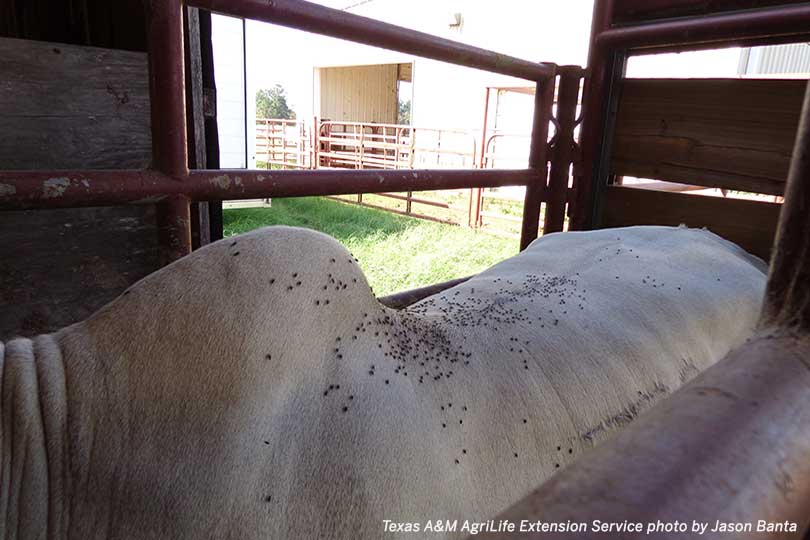By Shala Watson
TFB Public Relations Intern
Spring green up is here and the warmer temperatures are bringing unwelcome guests—flies and pests—to the farm.
Sanitation and prevention are the primary keys to managing pest problems in livestock and equine operations.
Horn flies and stable flies are the most common and can cost cattle operations hundreds of millions of dollars each year.
Before choosing a pest management plan, livestock owners should consider what types of flies or pests they are dealing with, their breeding areas and the environment.
The stable fly, the most significant livestock pest in the United States, can be costly to ranchers. And the level of harm increases when populations reach more than 20 per animal, according to Texas A&M AgriLife Extension.
Research shows the heavy infestation of stable flies on beef cattle can reduce weight gain by 25 percent.
Stable flies primarily gather on the legs of the animal. They develop from the egg to adult stage in about three to four weeks. An adult female stable fly lives for three to four weeks and lays 500 to 600 eggs during its lifetime.
Attacked animals will stomp and kick their legs, and cattle will typically herd together to try to avoid them.
“Stable flies are best managed by sanitation. They breed in decomposing vegetation and manure mixed with vegetation. Continual maintenance of manure and hay is a must,” Dr. Sonja Swiger, Texas A&M AgriLife Extension entomologist, said.
Livestock owners can manage stable flies by eliminating breeding sites. Stables should be kept clean and decomposing hay and other material should be removed to prevent colonization of stable flies. Wet food should not be left in troughs.
Horn flies, which are typically found on the animal’s back, shoulders, and sides, are the most damaging insect for beef cattle in Texas.
Research shows that a calf infested with more than 200 horn flies will weigh 15 to 50 pounds less at weaning.
Horn flies develop from the egg to the adult stage within 10 to 20 days and live for about three weeks. Topical products are available for the treatment of horn flies in cattle. Treating horses for horn flies is done with permethrin sprays and pour-ons.
The control methods for cattle—like the reduction of breeding sites and keeping manure picked up and spread—are also important for horses. Pests that can be a nuisance for horses include horn flies, stable flies and horse flies. Another pest horse owners should be aware of is bot flies.
“Bot flies also are a concern, not only because they cause the horse distress as they pursue and land on them, but they actually lay their eggs on their legs and sides, that the horse then ingests and these become the internal parasites, bots,” Dr. Dennis Sigler, Texas A&M AgriLife Extension horse specialist, said.
Sigler said an anthelmintic, such as Ivermectin, can be used to control internal bot larva. Horses should be dewormed at least twice a year—in the initial green up in the spring and the first killing frost in the fall.
Flies are not as much of a problem for sheep and goats like they are for cattle and horses, Sigler noted. Sheep keds and lice are the bigger external parasite problem. Owners can manage lice by shearing and treat using pour-ons.
Swiger said sheep keds (wool maggots) and blow flies can be an issue for sheep. Sheep keds can be controlled by spring shearing and then treating with an insecticide if there are large populations. Blow flies can be avoided by cleaning urine and feces and shearing lambs early.
A common pest that is an issue for all livestock is house flies.
Swiger said management of house flies is best controlled by good sanitation practices, keeping manure cleaned up and keeping feed dry and covered.
Bayer Animal Health experts offer suggestions for livestock owners to protect against seasonal pests.
Cattlemen can use ear tags, animal sprays and dusts and pour-on insecticides to control pests that primarily live on the animal. Baits, dusts or sprays can be used to treat barns, pens, stables and other facilities where pests are a problem.
A feed trough insecticide can be used to eliminate fly larva before they become a breeding ground and feeding location for flies.
Insecticide resistance can be managed by rotating the type of inse

